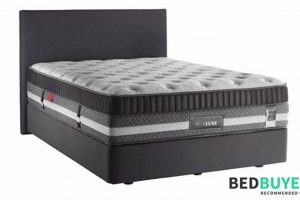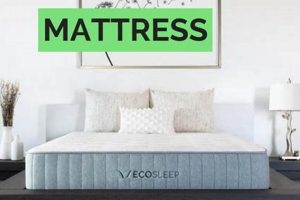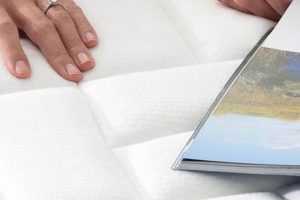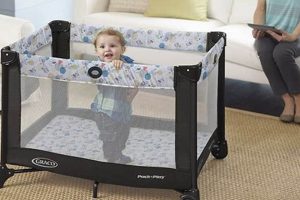The selection of appropriate sleeping surfaces for older individuals is a multifaceted consideration, integral to maintaining health and well-being. These specialized products address the unique physiological changes associated with aging, prioritizing pressure relief, support, and ease of movement. For instance, a conforming memory foam model can alleviate pressure points, while a firmer innerspring variant may offer enhanced spinal alignment.
Adequate sleep is demonstrably crucial for cognitive function, physical recovery, and overall quality of life, particularly within the geriatric population. Selecting a suitable sleep surface can mitigate discomfort, reduce nighttime awakenings, and contribute to improved circulation. Historically, advances in materials science and mattress technology have led to specialized designs tailored to the specific needs of older adults, moving beyond generic options to address concerns like arthritis, osteoporosis, and limited mobility.
The subsequent sections will explore key factors to consider when choosing a sleeping surface designed to promote restful and restorative sleep for older individuals, including material composition, support mechanisms, height considerations, and relevant safety certifications.
Guidance on Mattress Selection for Older Adults
Selecting a sleeping surface for an older individual necessitates careful consideration of various factors to promote comfort, support, and overall well-being. The following guidelines offer insights into making an informed decision.
Tip 1: Prioritize Pressure Relief: Opt for materials like memory foam or latex that conform to the body’s contours, minimizing pressure points on sensitive areas such as hips and shoulders. This is particularly crucial for individuals with arthritis or other joint pain.
Tip 2: Evaluate Support and Spinal Alignment: Ensure the mattress provides adequate support to maintain proper spinal alignment. A medium-firm or firm option may be beneficial, depending on individual preferences and physical condition.
Tip 3: Consider Edge Support: Strong edge support facilitates easier getting in and out of bed, enhancing stability and reducing the risk of falls. Reinforced edges are particularly advantageous for those with mobility limitations.
Tip 4: Assess Mattress Height: The height of the mattress should allow the individual to sit comfortably on the edge of the bed with their feet flat on the floor. Adjustability may be necessary to accommodate varying physical capabilities.
Tip 5: Explore Adjustable Bases: An adjustable base can provide customized positioning options, such as elevating the head or legs, which may alleviate discomfort associated with conditions like acid reflux or edema.
Tip 6: Investigate Breathability and Temperature Regulation: Choose mattresses with breathable materials and cooling technologies to minimize overheating and promote comfortable sleep, especially for those prone to night sweats.
Tip 7: Research Safety Certifications: Look for certifications such as CertiPUR-US, which ensure the mattress is made without harmful chemicals and volatile organic compounds (VOCs), contributing to a healthier sleep environment.
Adhering to these guidelines can lead to the selection of a sleeping surface that optimizes comfort, support, and safety for older adults, promoting restful sleep and improved overall health.
The subsequent sections will address specific mattress types and technologies, further elaborating on the considerations outlined above.
1. Pressure Relief
Pressure relief is a paramount consideration in the selection of a sleeping surface for the elderly, directly impacting comfort, minimizing pain, and promoting restful sleep. The physiological changes associated with aging often lead to increased sensitivity to pressure, making this attribute of utmost importance.
- Reduced Joint Stress
Aging frequently results in decreased joint flexibility and increased susceptibility to arthritis. Mattresses that effectively distribute weight minimize localized pressure on joints such as hips, shoulders, and knees. For example, memory foam or latex conforms to the body, evenly dispersing weight and reducing strain on these areas, promoting comfort and reducing pain.
- Improved Circulation
Prolonged pressure on specific areas can impede blood flow, leading to discomfort and potential complications. Pressure-relieving mattresses allow for improved circulation by reducing compression of blood vessels. This is particularly beneficial for individuals with circulatory issues, contributing to overall health and well-being.
- Prevention of Bedsores
Immobility and reduced skin elasticity in the elderly increase the risk of developing pressure ulcers (bedsores). Mattresses designed for pressure relief minimize sustained pressure on bony prominences, thus reducing the likelihood of skin breakdown. Materials like air mattresses or specialized foam mattresses are specifically designed to address this concern.
- Enhanced Sleep Quality
Discomfort caused by pressure points can lead to frequent awakenings and disrupted sleep patterns. By mitigating pressure-related pain, mattresses that prioritize pressure relief contribute to improved sleep quality, allowing for more restorative rest and promoting cognitive function and physical recovery.
In summary, pressure relief is an indispensable characteristic in sleeping surfaces designed for older adults. By reducing joint stress, improving circulation, preventing bedsores, and enhancing sleep quality, these mattresses play a crucial role in promoting comfort, health, and overall quality of life. Investing in a mattress with superior pressure-relieving properties is a proactive step toward ensuring a more comfortable and restful experience for the elderly.
2. Spinal Alignment
Maintaining proper spinal alignment during sleep is fundamentally important for the elderly, contributing significantly to comfort, pain management, and overall musculoskeletal health. Selection of an appropriate sleep surface plays a crucial role in achieving and preserving optimal alignment.
- Prevention of Back Pain
Improper spinal alignment exacerbates existing back pain or initiates new discomfort. A mattress failing to provide adequate support allows the spine to curve unnaturally, straining muscles and ligaments. The best mattress options promote a neutral spinal position, reducing stress on the vertebral column and alleviating associated pain.
- Reduction of Nerve Compression
Misalignment can compress nerves along the spine, leading to radiating pain, numbness, or tingling sensations. A w
ell-chosen mattress mitigates this compression by maintaining the natural curvature of the spine, particularly in the lumbar region. Support for the cervical spine is equally vital, requiring a pillow that complements the mattress in ensuring neck alignment. - Promotion of Muscle Relaxation
Proper spinal alignment facilitates muscle relaxation throughout the body. When the spine is adequately supported, muscles do not need to work excessively to maintain posture, reducing muscle tension and promoting restful sleep. This contributes to improved circulation and overall comfort.
- Enhancement of Respiratory Function
Severe spinal misalignment can restrict lung capacity and hinder respiratory function. While a mattress primarily addresses alignment in the supine and lateral positions, its contribution to postural support can indirectly influence respiratory mechanics. Optimizing alignment encourages deeper, more efficient breathing during sleep.
The characteristics of an optimal sleep surface for the elderly necessitate a balanced approach, delivering both conforming support and adequate firmness to ensure proper spinal alignment. The choice of mattress material, internal construction, and overall design must prioritize the preservation of the spine’s natural curvature, thereby promoting comfort, mitigating pain, and fostering enhanced well-being.
3. Edge Support
Edge support is a critical characteristic in a sleeping surface designed for older adults. Its presence, or lack thereof, directly impacts ease of ingress and egress, stability, and overall safety. Weak edge support can lead to instability when an individual sits on the edge of the bed, increasing the risk of falls, a significant concern for the elderly population. Adequate edge support provides a firm, stable surface, facilitating safer transfers to and from a standing or sitting position. Consider, for instance, an older individual recovering from hip surgery; robust edge support becomes invaluable in minimizing strain and promoting independence during mobility.
The design of a sleeping surface significantly influences its edge support capabilities. Innerspring models often incorporate reinforced coils around the perimeter to enhance stability. Foam mattresses may employ denser foam layers along the edges to achieve a similar effect. Hybrid models typically combine both techniques. The selection of a mattress with documented and demonstrable edge support capabilities directly contributes to the usability and safety of the sleeping environment. Absence of suitable edge support can necessitate reliance on assistive devices or caregiver assistance, potentially compromising an individual’s sense of autonomy.
In summary, the inclusion of substantial edge support is a non-negotiable element in a mattress intended for elderly users. It directly addresses fall prevention, facilitates independent mobility, and promotes a sense of security. Neglecting this aspect can undermine the benefits of other mattress features, ultimately diminishing the overall effectiveness and suitability of the sleeping surface. Therefore, a thorough evaluation of edge support should be a primary step in the mattress selection process.
4. Mattress Height
Mattress height is a critical, yet often overlooked, factor when selecting a sleeping surface for elderly individuals. The vertical dimension of the mattress significantly impacts ease of access, safety, and overall comfort, directly influencing the user’s ability to independently enter and exit the bed.
- Optimizing Transfer Height
The ideal mattress height allows an individual to sit comfortably on the edge of the bed with feet flat on the floor and knees at a 90-degree angle. This posture facilitates safe and stable transfers, minimizing strain on joints and reducing the risk of falls. For example, a bed that is too low requires excessive bending, while one that is too high may necessitate climbing, both presenting potential hazards for older adults with mobility limitations.
- Accommodation of Medical Equipment
In certain circumstances, elderly individuals require the use of medical equipment, such as hospital beds or adjustable bases, which may alter the overall bed height. Selecting a mattress that is compatible with these devices is essential to maintain optimal transfer height and ensure the equipment functions as intended. Considerations must be given to the thickness of the mattress in relation to the adjustable range of the bed frame.
- Impact on Caregiver Assistance
Mattress height also affects the ergonomics of caregiver assistance. A bed that is appropriately height can minimize strain on caregivers when providing assistance with transfers, repositioning, or other aspects of personal care. A bed that is too low may require the caregiver to bend excessively, increasing the risk of back injury. Conversely, a bed that is too high may make it difficult for the caregiver to provide assistance effectively.
- Psychological Considerations
Beyond physical factors, mattress height can also influence psychological well-being. A bed that is easily accessible promotes independence and reduces feelings of vulnerability. Conversely, a bed that is difficult to get in and out of may contribute to anxiety and frustration. Maintaining a sense of autonomy is crucial for preserving quality of life in the elderly, and mattress height plays a tangible role in supporting this.
The optimal mattress height for an elderly individual is a personalized determination, contingent upon their physical capabilities, medical needs, and the presence of assistive devices or caregivers. Careful assessment of these factors ensures that the selected mattress contributes to a safe, comfortable, and supportive sleeping environment.
5. Temperature Regulation
Effective temperature regulation in a sleeping surface is a critical attribute, especially when considering optimal mattress selection for elderly individuals. Thermoregulatory capabilities decline with age, rendering older adults more susceptible to temperature fluctuations and their associated discomfort. Mattresses exhibiting poor thermal properties can lead to overheating or excessive cooling, disrupting sleep cycles and potentially exacerbating existing medical conditions. For instance, a mattress constructed from dense, non-breathable materials traps body heat, creating an environment conducive to night sweats and restlessness. Conversely, a mattress failing to provide sufficient insulation may lead to chilling, particularly in colder climates, thereby disrupting sleep and potentially aggravating conditions like arthritis.
The materials used in mattress construction exert a significant influence on temperature regulation. Natural fibers like cotton and wool, known for their breathability and moisture-wicking properties, promote air circulation and dissipate heat, creating a cooler sleeping environment. Open-cell foam structures and gel-infused memory foam are designed to mitigate heat retention, providing enhanced airflow and improved temperature control. Furthermore, the
use of advanced technologies, such as phase-change materials, enables mattresses to actively regulate temperature by absorbing and releasing heat as needed, maintaining a consistent and comfortable sleeping surface. Individuals residing in warmer climates or those prone to night sweats benefit significantly from mattresses incorporating these advanced temperature-regulating technologies. A practical application involves selecting mattresses with specialized cooling covers that further enhance breathability and moisture management, contributing to a more restful sleep experience.
In conclusion, temperature regulation constitutes an indispensable consideration in the selection of a sleeping surface for elderly individuals. Failure to prioritize this aspect can lead to sleep disturbances, discomfort, and potential health complications. The incorporation of breathable materials, innovative cooling technologies, and a comprehensive understanding of individual thermoregulatory needs are paramount in ensuring a comfortable and restorative sleep environment for the geriatric population. Overcoming the challenges associated with age-related thermoregulatory decline requires a proactive and informed approach to mattress selection, ultimately contributing to improved health outcomes and enhanced quality of life.
6. Safety Certifications
Safety certifications serve as verifiable attestations that a mattress complies with established safety and quality standards. Within the context of selecting an optimal sleeping surface for elderly individuals, these certifications hold particular significance due to the increased vulnerability of this demographic to environmental hazards and potential health risks.
- Reduced Exposure to Harmful Chemicals
Certifications such as CertiPUR-US guarantee that the mattress foam has been tested and found to be free of harmful chemicals, including formaldehyde, heavy metals, and prohibited phthalates. Elderly individuals often possess heightened sensitivity to chemical exposure, making this assurance critical in minimizing respiratory irritation, allergic reactions, and potential long-term health consequences. For instance, a mattress lacking this certification could emit volatile organic compounds (VOCs), negatively impacting indoor air quality and posing risks to individuals with pre-existing respiratory conditions.
- Flame Retardant Compliance
Regulations mandate that mattresses meet flammability standards to reduce the risk of fire hazards. Safety certifications confirm that the mattress has undergone rigorous testing and complies with these standards, often employing flame retardant materials that are considered safer alternatives to older chemical treatments. This is crucial for ensuring the safety of elderly individuals who may have limited mobility or cognitive impairments, hindering their ability to react quickly in the event of a fire.
- Allergen and Irritant Control
Certain certifications address the presence of allergens and irritants, such as dust mites, mold, and mildew, which can exacerbate respiratory issues and allergic reactions. Mattresses with certifications indicating hypoallergenic properties or resistance to microbial growth provide a healthier sleeping environment for elderly individuals who are prone to allergies or have compromised immune systems. Selecting a mattress with this assurance reduces the risk of allergic reactions and promotes better respiratory health.
- Durability and Longevity Assurance
While not directly related to immediate health hazards, certifications that assess the durability and longevity of a mattress provide an indirect safety benefit. A mattress that maintains its structural integrity and support over time reduces the risk of sagging, uneven surfaces, and potential falls. This is particularly important for elderly individuals who may have balance issues or require a stable sleeping surface for mobility and comfort. A durable mattress also represents a more cost-effective long-term investment, minimizing the need for frequent replacements and reducing potential disruptions to sleep and well-being.
Therefore, incorporating safety certifications into the mattress selection criteria for elderly individuals contributes significantly to mitigating potential health risks, ensuring a safe and comfortable sleeping environment, and promoting overall well-being. These certifications provide a tangible measure of assurance that the mattress meets established standards for chemical safety, flammability, allergen control, and durability, offering peace of mind and contributing to improved quality of life.
Frequently Asked Questions Regarding Suitable Mattresses for Older Adults
This section addresses common inquiries and clarifies key considerations pertaining to selecting appropriate sleeping surfaces for the elderly population. The information provided aims to inform decision-making and promote optimal comfort and safety.
Question 1: What specific mattress features are most beneficial for individuals with arthritis?
Sleeping surfaces designed to alleviate arthritic discomfort should prioritize pressure relief. Memory foam and latex materials are often recommended due to their conforming properties, which distribute weight evenly and minimize pressure on sensitive joints. Adequate support to maintain spinal alignment is also crucial.
Question 2: How does mattress height affect safety and mobility for elderly users?
An appropriate mattress height facilitates ease of entry and exit from the bed, reducing the risk of falls. The ideal height allows the individual to sit comfortably on the edge of the bed with feet flat on the floor and knees bent at a 90-degree angle. Bed frames and adjustable bases can be utilized to achieve this optimal height.
Question 3: Are innerspring mattresses suitable for elderly individuals, or are foam mattresses preferable?
Both innerspring and foam mattresses can be suitable, contingent upon specific needs and preferences. Innerspring mattresses with individually wrapped coils can provide targeted support and minimize motion transfer. Foam mattresses, particularly those made of memory foam or latex, excel at pressure relief. Hybrid models combining both innerspring and foam technologies offer a balance of support and comfort.
Question 4: Why is edge support considered an important feature in mattresses for the elderly?
Strong edge support enhances stability and facilitates safer transfers in and out of bed. Elderly individuals often rely on the edge of the mattress for support when sitting or standing, and inadequate edge support can increase the risk of falls. Reinforced edges are therefore a critical safety feature.
Question 5: What safety certifications should one look for when purchasing a mattress for an older adult?
Certifications such as CertiPUR-US ensure that the mattress is manufactured without harmful chemicals, including formaldehyde, heavy metals, and prohibited phthalates. This certification minimizes potential exposure to volatile organic compounds (VOCs) and contributes to a healthier sleep environment. Flame retardant compliance is also important.
Question 6: How does temperature regulation influence sleep quality for the elderly?
Thermoregulatory capabilities often decline with age, making temperature regulation a crucial factor in mattress selection. Mattresses with breathable materials, su
ch as cotton or wool, and cooling technologies, such as gel-infused foam, can help prevent overheating and promote comfortable, restorative sleep.
Selecting a sleeping surface for an older adult necessitates careful consideration of individual needs and preferences. Prioritizing pressure relief, spinal alignment, safety, and comfort is essential for promoting restful sleep and overall well-being.
The subsequent section will provide actionable recommendations for assessing mattress suitability in a practical setting.
Concluding Remarks on Optimal Mattress Selection for Older Adults
This discourse has comprehensively examined essential attributes of sleeping surfaces intended for the elderly. Emphasis has been placed on pressure relief, spinal alignment, edge support, mattress height, temperature regulation, and adherence to rigorous safety certifications. These elements collectively determine the suitability of a mattress in promoting restful sleep, mitigating discomfort, and minimizing potential hazards for a vulnerable demographic.
The selection of an appropriate sleeping surface constitutes a significant investment in the health and well-being of older individuals. Careful consideration of the factors discussed herein, combined with professional medical advice, will facilitate informed decision-making, fostering improved sleep quality and a higher overall quality of life for aging populations. Diligence in this pursuit is not merely advisable but necessary.


![Top-Rated: Choosing the Best Mattress Foundation [Guide] Organic & Natural Mattress Buyer’s Guide: Non-Toxic Sleep Solutions Top-Rated: Choosing the Best Mattress Foundation [Guide] | Organic & Natural Mattress Buyer’s Guide: Non-Toxic Sleep Solutions](https://mattressworldpa.com/wp-content/uploads/2025/07/th-7633-300x200.jpg)




![How to Find the Best Way Twin Air Mattress [Guide] Organic & Natural Mattress Buyer’s Guide: Non-Toxic Sleep Solutions How to Find the Best Way Twin Air Mattress [Guide] | Organic & Natural Mattress Buyer’s Guide: Non-Toxic Sleep Solutions](https://mattressworldpa.com/wp-content/uploads/2025/07/th-7628-300x200.jpg)